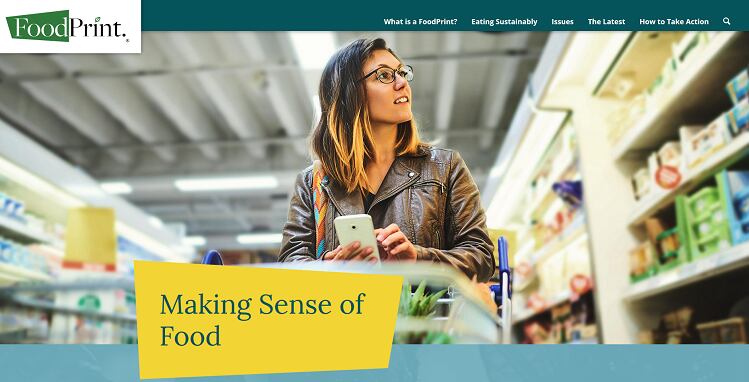FoodPrint.org, which officially launched this week, is part of GRACE Communications Foundation, an organization that advocates for increased public awareness of environmental and public health issues created by the current industrial food system.
“As an organization we have a vision for a more sustainable food system, and it’s a holistic one. So this includes the daily decisions that consumers make and also pressing for more systemic change,” said Jerusha Klemperer, program director of FoodPrint during a webinar Tuesday to introduce the new website.
“This site is truly unique and we’re very excited about it because it really brings those two things together for visitors,” she added. “It touches on how do you approach the issue of sustainable food in a daily pragmatic way, but also how to dig much deeper on those issues, and how to press for that larger change.”
On the website’s top bar, visitors can look for information sorted by ‘Issues’ (animal welfare, food and the environment, social justice and food production, public health, and more). Visitors can also sort information by occasion, such sustainable dining out, sustainable shopping, sustainable cooking, and more.
Consumers have values… but they aren’t necessarily shopping according to values
Timed around the website’s launch, GRACE Communications also released the results of its national survey conducted together with GfK.
They found that of 1,000 nationally representative US adults 66% say they were ‘driven’ by wanting locally and seasonally grown vegetables. Almost 40% are driven by wanting animals who are treated well and products from animals that are treated well.
“People really do have values that connect them to their food and they’re driven by those values,” said Urvashi Rangan, PhD, chief science advisor at GRACE Communications Foundation during the webinar.
“But we also found that consumers aren’t necessarily making the right choices to meet their values, and in that way, one result we found was that, while only 25% of people surveyed said they look for organic food when they shop, nearly 50% of people surveyed said they want to avoid harmful pesticides,” she added.
“Well, that’s exactly what organic is, and yet half of the people looking for lower pesticides residues aren’t actually shopping for organic. Again, it’s yet another reason we want to bring FoodPrint to the fore here,” so consumers know the solutions out there to help them meet their values, Rangan said.
FoodPrint.org includes what Rangan called “an extensive labeling tool” called its Food Label Guide. The most common food labels—USDA Organic, Non GMO Project verified, and Certified Naturally Grown—have easy access for visitors, broken down by product (beef, pork, dairy, produce, etc.)
The tool then lists the organization’s ‘Top Picks’ (under ‘Eggs,’ for example, their top picks were Animal Welfare Approved, USDA Organic, and Demeter Certified Biodynamic) as well as labels lacking clear standards (also under ‘Eggs’ were claims like free range, cage free, natural, and vegetarian-fed).
A tool to be part of a suite of tools
“This [label] guide is one tool that’s part of a suite of tools,” Klemperer told FoodNavigator-USA. “And we like that it’s on the website along with other information. It’s really important to us that the guide can be used as a portal to deeper learning.”
Rangan added that the number of criteria used in its label guide is “pretty comprehensive” compared to similar label guides.
Similar-minded company HowGood, for example, ranks items at the grocery store based on a long list of criteria such as labor laws and environmental sustainability, but what consumers see at first glance is just the rating.
By accessing FoodPrint.org’s label guide, “we don’t leave it to you to necessarily press us behind the curtain, we’re putting it all out there,” Rangan said.

